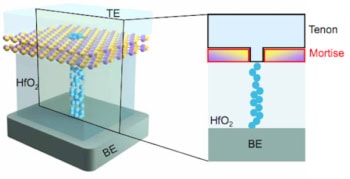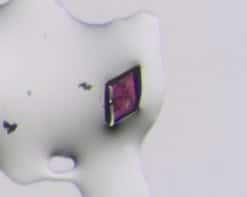
Films of vertically grown halide perovskites (VGHPs) can be used to make efficient nanopillar photodetectors, according to new work by researchers in Korea. The structures, which are made using a nanoimprinting crystallization technique, have a low defect density and high electrical conductivity. The photodetectors have an increased photoresponsivity compared to flat film-based devices.
Halide perovskites have the chemical formula ABX3 (where A is typically methylammonium, formamidinium or caesium, B is lead or tin, and X iodine, bromine or chlorine). They show much promise as next-generation photoelectronic materials thanks to their excellent photophysical properties. These include a tuneable optical absorption bandgap, slow recombination kinetics (the rate at which electron–hole pairs recombine to make a photon) and the fact that charge carriers can diffuse through them quickly and over long lengths.
Most research to date has focused on engineering these materials’ composition and interfacial properties. As a result, researchers have succeeded in increasing the power-conversion efficiency (PCE) of solar cells made from perovskites from just 3% to more than 22% in recent years.
Reduced defect density and improved charge-carrier mobility
A team led by Jong Hyeok Park of Yonsei University in Seoul and Jeong Ho Cho of Sungkyunkwan University in Suwon has now developed a new and simple way to make VGHP nanopillar films using engraved nanopatterned polymer stamps to form nanopillars. The researchers grew their nanostructures by crystallizing a softly baked methylammonium lead iodide (MAPI) gel film.
“Previous work by our group showed that the pressure induced by the nanopatterned polymer stamps changes the crystallinity of the halide perovskite films,” explain Park and Cho. “In this new work, we designed the perovskites with a 1D geometry and observed reduced defect density and improved charge-carrier mobility in the MAPI films, as measured with time-resolved photoluminescence (PL) spectroscopy and conductive atomic force microscopy.”
The researchers found that the defect density in the VGHP films was reduced by approximately one-fifth – from 5.27 × 1017 to 9.81 × 1016. These values are almost the same as those of a typical polycrystalline MAPI film. They also observed that the pressurizing process shrinks the perovskite grain boundaries, which normally behave as defect sites after the nanoimprinting process. The reduced defect density extends the carrier diffusion length and enhances the charge-carrier mobility, they say.
Park, Cho and their colleagues, reporting their work in ACS Nano 10.1021/acsnano.8b04170, then turned their attention to making two-terminal photodetectors using the nanopillar films. They illuminated the perovskite channel region with light of a wavelength of 520 nm and an optical power of 500 μW. Photoabsorption generates electron−hole pairs in the channel layer, which subsequently dissociate into holes and electrons under the electric field applied between the two electrodes in the device, dramatically enhancing the photocurrent (the rate at which electron–hole pairs are created).
The VGHP photodetectors also boast lower dark current (or unwanted leakage current) compared to their flat film-based counterparts thanks to their reduced channel thickness (∼130 nm) and decreased defect density, add the researchers. And importantly, they also have an increased “responsivity” (efficiency in generating charge carriers when photons hit the photodetector).

2D perovskites make brilliant blue-light emitters



